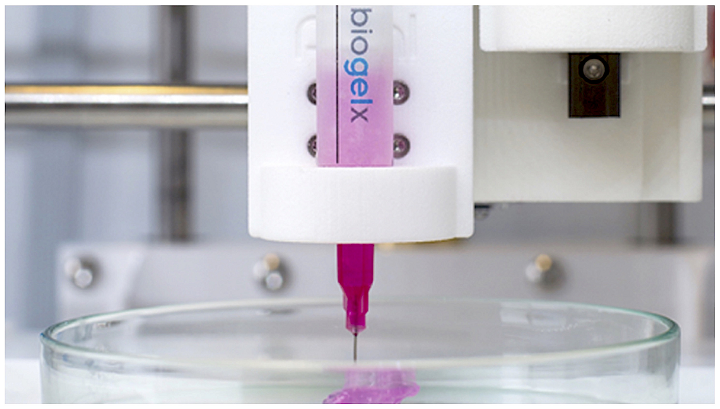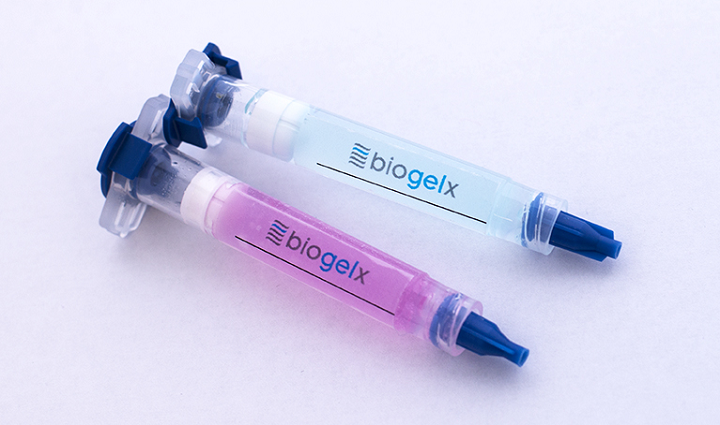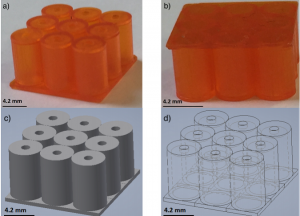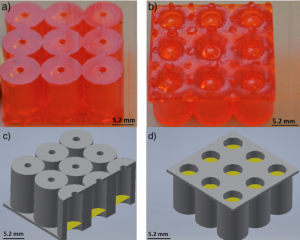Biogelx and Regemat 3D partner to provide complete 3D bioprinting solutions
Biogelx commences international strategy launching 3D bioprinting material in Brazil
Biogelx Launching First Product Range of Synthetic Bioinks for Variety of 3D Printing Applications
In 2013, a company called Biogelx was spun out from the University of Strathclyde in Glasgow, Scotland for the purposes of developing tunable, synthetic materials for use in 3D cell cultures and 3D bioprinting applications. Early on, the company worked on creating 3D cell culture scaffolds, which were in the form of synthetic peptide hydrogels so as to support cell growth by behaving as an extracellular matrix environment.
Bioinks are loaded up with cells in order to 3D print biological structures. Then, once the structure is printed, secondary crosslinking mechanisms help retain the shape’s structural fidelity. These bioprinting materials can facilitate cell adhesion, differentiation, and proliferation, as well as exhibit all the characteristics of an extracellular matrix environment. This is what makes it possible to create patient-specific human tissues in a laboratory setting, which is why good bioinks are very important.
 Biogelx’s hydrogel bioinks have unique physical and chemical tunability, which means they can successfully replicate specific tissue characteristics so cells can engage with, and experience, a 3D environment that’s pretty close to real life. Early on, the industry recognized how beneficial Biogelx’s hydrogel bioinks could be for researchers in the industry, as the materials claim to offer reproducibility, great printability, an easy crosslinking method, and viscosity control in one package. The company’s bioinks can provide a base modular material where the cells’ chemical and mechanical properties are able to be adapted.
Biogelx’s hydrogel bioinks have unique physical and chemical tunability, which means they can successfully replicate specific tissue characteristics so cells can engage with, and experience, a 3D environment that’s pretty close to real life. Early on, the industry recognized how beneficial Biogelx’s hydrogel bioinks could be for researchers in the industry, as the materials claim to offer reproducibility, great printability, an easy crosslinking method, and viscosity control in one package. The company’s bioinks can provide a base modular material where the cells’ chemical and mechanical properties are able to be adapted.
That’s why Biogelx is proud to launch its first product range of novel, synthetic bioinks: Biogelx-INKS. As the company says on its website, the future is synthetic.
“We are excited to announce the commercial availability of Biogelx
-INKs,” said Biogelx CEO, Mitch Scanlan. “Providing versatility and improving research outcomes are the key focuses for our product portfolio. We look forward to supporting researchers in their mission to develop realistic 3D disease modules, tissues, and organs for future pharmaceutical and medical applications.”
Developed with 3D printability at the forefront, Biogelx-INKs have been optimized for use in extrusion 3D printers, and they’re also versatile enough to work in 3D printing applications other than just bioprinting. The bioinks maintain the company’s core self-assembling peptide technology, and just like Biogelx’s hydrogel products, these new Biogelx-INKs form a nanofibrous network in order to mimic an extracellular matrix environment. This supports cell growth, proliferation, and signaling, but in addition, Biogelx-INKs were developed in such a way as to, as the company put it, “ensure the rheological properties are suitable for bioprinting applications.”
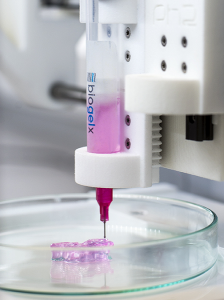 According to the Biogelx website, its new bioinks can be printed with good 3D fidelity, and don’t require any support, sacrificial, or curing inks. Biogelx-INKs also offer important shear-thinning behavior, which helps with cell viability, and controllable gelation, which is triggered by adding cell culture media and does not require the addition of reactive crosslinking reagents, UV curing, adjustments in pH, or extreme temperature. This feature also makes the material compatible with many different 3D bioprinters.
According to the Biogelx website, its new bioinks can be printed with good 3D fidelity, and don’t require any support, sacrificial, or curing inks. Biogelx-INKs also offer important shear-thinning behavior, which helps with cell viability, and controllable gelation, which is triggered by adding cell culture media and does not require the addition of reactive crosslinking reagents, UV curing, adjustments in pH, or extreme temperature. This feature also makes the material compatible with many different 3D bioprinters.
The company’s technology is based on a system of two peptides – a hydrophobic ‘gelator’ peptide (Fmoc-diphenylalanine) and a hydrophilic ‘surfactant’ (Fmoc-serine) – which self-assemble to form fibers in aqueous environments. These fibers have surface hydrophilic functionality, which is appropriate for cell adhesion.
Additional features of Biogelx-INKs include:
- Reproducible – these bioinks are totally synthetic and manufactured under strict quality control, which ensures batch-to-batch reproducibility and consistent prints.
- Tuneable – it’s possible to tailor the biomimetic functionality of the bioinks to specific cell types.
- Biocompatibility – composed of amino-acids, Biogelx-INKs are >95% water and produce a nanoscale structure which mimics the natural extracellular matrix environment.
- Material Biomimicry – this product range includes formulations that incorporate several biomimetic peptide sequences, which increases its biocompatibility with various cell types.
According to the Bioglex website, “With our core technology, our bioinks can be tailored to specific applications, meaning they have huge potential in a range of fields including cell research, toxicology, drug screening, and regenerative medicine.”
If you’re interested in the company’s new range of Biogelx-INKs, you can order the product, in one of three sizes, for £280.
Discuss this story and other 3D printing topics at 3DPrintBoard.com or share your thoughts in the Facebook comments below.
[Images: Biogelx]
3D Printing Industry research CrAMmed: MIT, National Academy of Engineering, Aalto University, Optomec
3D Printing News CrAMmed, University of Maryland, SUTD, TU Delft, RWTH Aachen University
Could Your Next Headphones Use 3D Printed Metamaterials?
We’ve often seen 3D printing used to fabricate headphones and earbuds. But a team of researchers from the Department of Electrical and Electronic Engineering in the University of Strathclyde in Glasgow are taking this idea to the next level with acoustic metamaterials. Metamaterials, which can morph according to their environment, make up a new class of finely-engineered surfaces that can perform nature-defying tasks like 3D printing holograms and shaping sound waves. Acoustic metamaterials have the unique ability to attenuate sound by breaking the mass-density law, due to properties such as negative effective density and bulk modulus – no easy feat when it comes to small devices since thin walls are easily penetrated by acoustic waves.
 The researchers, who are all affiliated in various capacities with the university’s Centre for Ultrasonic Engineering (CUE), recently published a paper, titled “Enhancing the Sound Absorption of Small-Scale 3D Printed Acoustic Metamaterials Based on Helmholtz Resonators,” detailing how their SLA 3D printed acoustic metametarials, based on Helmholtz resonators, can be used for small-scale sound absorption applications.
The researchers, who are all affiliated in various capacities with the university’s Centre for Ultrasonic Engineering (CUE), recently published a paper, titled “Enhancing the Sound Absorption of Small-Scale 3D Printed Acoustic Metamaterials Based on Helmholtz Resonators,” detailing how their SLA 3D printed acoustic metametarials, based on Helmholtz resonators, can be used for small-scale sound absorption applications.
The abstract reads, “The directional response due to the position of the acoustic source on the sound attenuation provided by the metamaterial is investigated by controlling the location of a loudspeaker with a robot arm. To enhance and broaden the absorption bands, structural modifications are added such that overtones are tuned to selected frequencies, and membranes are included at the base of the resonators. This design is made possible by innovative 3D printing techniques based on stereolithography and on the use of specific UV-curable resins. These results show that these designs could be used for sound control in small-scale electroacoustic devices and sensors.”
To cut a material’s sound transmission by half, you have to double its acoustic frequency, density, or thickness. When an acoustic metamaterial has negative parameters, stop bands will form where the sound is deeply attenuated at certain frequencies.
“Acoustic metamaterials can break the mass-density law by exploiting the stop bands formed in the proximity of the resonance frequencies of their unit cells,” the researchers explain. “These material structures are often based on Helmholtz resonators and membranes. The frequency band that is attenuated by using these kind of unit cells is nevertheless narrow, hence solutions such as coupling of multiple resonances and leveraging the losses of the materials are generally used to make the attenuation broadband.”
The team’s paper presents a basic design of these small-scale, sub-wavelength 3D printed acoustic metamaterials, which use Helmholtz resonators arrays to generate stop bands where sound attenuation increases with the number of unit cells. A loudspeaker, guided by a KUKA robot arm through a quarter-hemisphere trajectory, illustrated that an absorption band forms “for every angle of incidence of the impinging sound wave.” A reference microphone was used to measure sound transmission in the air, while the transmission above the sample was measured by a second microphone.
The paper also explains two methods of enhancing the stop band, the first of which requires the resonators’ overtones to be tuned more closely to the fundamental frequency; this causes the band to grow wider. The second method involves printing membranes at the resonators’ base.
“In this work a novel fabrication technique is used, where thin membranes are fabricated inside Helmholtz resonators, the two units consisting of different materials,” the researchers wrote. “The presented manufacturing technique could result in rapid prototyping of metamaterials and contribute to the advancement of this field into the industrial environment. Simple physical models of the presented metamaterials are included in each section, nevertheless this work is mostly based on experimental results and aims at developing metamaterials that could be included in real devices. Potential applications of this work include noise cancellation for devices such as headphones, hearing aids and other sensors.”
Work is continuing to advance acoustic metamaterials in applications like acoustic cloaking, sound focusing and waveguiding, and imaging and computation, but the results are not often integrated into functional devices. But if studies like this one by the University of Strathclyde researchers can be validated, we could be looking at vastly improved headphones in the near future.
Co-authors of the paper are IEEE Student Member Cecilia Casarini, Benjamin Tiller, Carmelo Mineo, Charles N. MacLeod, IEEE Senior Member Professor James F. C. Windmill, and Joseph C. Jackson.
Discuss this research and other 3D printing topics at 3DPrintBoard.com or share your thoughts below.

